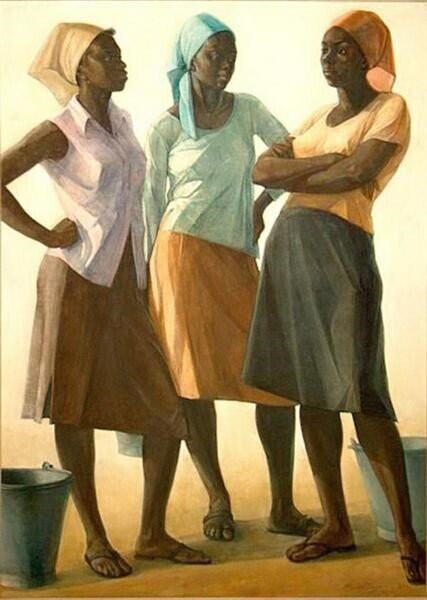This fall, the Dallas Museum of Art (DMA) presents “Afro-Atlantic Histories”—an unprecedented exhibition that visually explores the history and legacy of the Black diaspora, with a focus on the transatlantic slave trade on the final stop of its U.S. tour.
Initially organized and presented in 2018 by the Museu de Arte de São Paulo (MASP), the exhibition comprises around 100 artworks and documents produced in Africa, the Americas, the Caribbean, and Europe from the 17th century to the present day, including works from the DMA’s own collection. The presenting sponsor for this exhibition is Bank of America.
“Now more than ever, we appreciate the power of the arts to foster human connection and encourage greater cultural understanding. Bank of America’s support of the DMA over the years, including the “Afro-Atlantic Histories” exhibition premiering in October, is core to our commitment to champion diverse voices, enrich and educate our society, and champion the communities we serve,” said Jennifer Chandler, Bank of America Dallas president.
“Afro-Atlantic Histories” is a rich and revelatory exploration of visual culture that offers a deeply international vision of Black aesthetic traditions,” added Ade Omotosho, The Nancy and Tim Hanley Assistant Curator of Contemporary Art.
“Rather than organize artworks chronologically, the exhibition unfolds thematically, which yields compelling juxtapositions that reveal the ways the past lingers in the present,” she said.

Works span different eras, geographies, genres, and media. The groupings together offer an expansive retelling of the many histories of the Afro-Atlantic. The Maps and Margins section focuses on the beginnings of the slave trade and the passage between Africa and the Americas, and how artists have represented and reinterpreted the histories within.
Invoking and responding to imagery of slave ships and the continents they traveled between, this section traces the forced migration that resulted in an interconnected Atlantic world.
The Resistances and Activisms grouping responds to the powerful pursuit of self-determination, beginning with Haitians’ declaration of independence in 1804. Works in this section reflect visual protest strategies in demonstrations, banners, textiles, and performance that have circulated throughout the Black Atlantic and have played a central role in the continuing struggle for full and dignified freedom.
The Enslavements and Emancipations section considers the violence and terror of slavery in the context of the struggle for emancipation, centering resistance within the histories of enslavement. These works confront brutality by incorporating historic images of slavery, evoking the horrors and trauma from these histories, which still persist today.
The Portraits grouping presents depicts Black people from the 17th century through the present, including some of the most celebrated Afro-Atlantic portraits in the history of art and others not traditionally memorialized in historical American and European portrait galleries.
The Rites and Rhythms section highlights spiritual and musical practices that have been central to the cultures of the Black Atlantic, depicting various types of music and dance from merengue in the Dominican Republic to jazz in the United States, as well as the many interconnected forms of festivals, ceremonies, and religious rituals across the Americas and the Caribbean.
The Everyday Lives segment includes images of daily life in Africa, the Caribbean, and the Americas that reflect moments of labor and leisure in Black communities. Thematically organized paintings propose a dialogue within the contexts of farms, markets, street scenes, and interiors, with works made by Europeans and Euro-Americans that often romanticized Black subservience. These works hang alongside later imagery by Afro-descendant artists detailing daily activities of Black life in more humanistic ways, in addition to the realities of racial inequities and state violence.
Juxtaposing historical artworks with contemporary works by artists of the Black diaspora, including Kara Walker, Hank Willis Thomas, Titus Kaphar, Firelei Báez, Zanele Muholi, and Nina Chanel Abney, the exhibition fosters dialogues across time and reexamines histories of enslavement, resistance, and the struggle for liberation from a global perspective.
“Ambitious in its scope and scholarship, “Afro-Atlantic Histories” offers a wide range of new perspectives and a deeper understanding of the connections between the cultures of the Black Atlantic.”
In support of “Afro-Atlantic Histories,” the DMA will host a free two-day community celebration, with performances, tours, films, art making, food trucks, and more! Entrance to the special exhibition “Afro-Atlantic Histories” will be FREE the entire weekend–”Revelation & Celebration: Black History and Culture” on November 18 and November 19 11 a.m. – 5 p.m., underwritten by Arlene J. Ford, PhD, and Christopher P. Reynolds, with free special exhibition admission presented by Kimberly-Clark.
“Afro-Atlantic Histories” is on view at the DMA from October 22, 2023, through February 11, 2024.
For a list of partners and supporters of the exhibit and to learn more about The DMA, visit www.dallasartsdistrict.org/events/.



